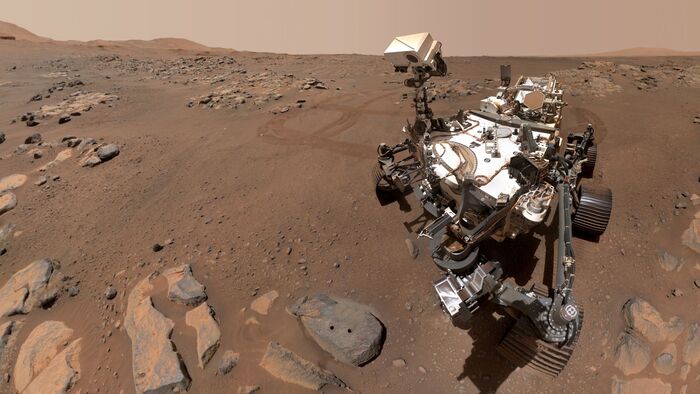The stillness that emerges from the images that come from Mars does not correspond to the reality of the planet: it is a dead but active landscape.
And now, for the first time, NASA and an international consortium of scientists have managed to capture the sound of a Martian dust swirl.
The constant frequency of these whirlwinds is a challenge for the
rovers
sent there by humanity, as they can suffer breakdowns when sand seeps into their electronic innards.
The registered eddy occurred in the Martian crater Jezero in September 2021, where the Perseverance
robot has been stationed
since last year, within the
mission to Mars 2020
in an active search for signs of liquid water millions of years ago and, perhaps, life. .
This meteorological phenomenon reached 118 meters in height and 25 meters in diameter—ten times larger than the NASA vehicle—and passed through it completely.
NASA's 'Perseverance' robot photographs the Jézero crater on Mars, in May 2021.HANDOUT (AFP)
"We had a one in 200 chance of registering it," says smiling planetologist Naomi Murdoch, from the Higher Institute of Aeronautics and Space at the University of Toulouse in France, who is leading the research.
“There was a lot of planning, but also luck: the microphone takes measurements for a little less than 3 minutes and
a priori it is unknown when a
dust devil
is going to happen
,” she admits by videoconference.
More information
Naomi Murdoch: "Asteroids can help answer the big question of how life arose"
The recording of the event and the measurements of the data are published today in the scientific journal
Nature Communications
and the article is signed by several Spanish scientists.
One of his coatures, the physicist Ricardo Hueso, from the Planetary Sciences Group of the University of the Basque Country (UPV/EHU), celebrates the finding: "It is a unique event, the sound of a dust eddy had not been recorded before, We didn't think we were going to capture it with all the instruments at once”.
In charge of the analysis of the work on atmospheric pressure, Hueso summarizes the importance of this unprecedented record: "The findings may improve our understanding of changes on the surface, dust storms and climate variability on Mars, which may have implications for future space exploration.
The UPV/EHU Planetary Sciences group: Itziar Garate, Agustín Sánchez-Lavega, Ricardo Hueso and Jon Legarreta.Mitxi (UPV/EHU)
The Perseverance
Martian rover
It is a technical prodigy that had international participation throughout its development, such as the construction of the environmental measurement sensors (MEDA) at the CSIC's Center for Astrobiology.
Physicist Álvaro Vicente-Retortillo, also a participant in the study, highlights that what makes this discovery something special is having managed to record the chance encounter multisensorily: wind, pressure, air temperature, solar and thermal radiation from the surface, the relative humidity of the environment, as well as the images of the whirlwind.
"MEDA provides very valuable information to better understand the properties of dust on Mars, which is important due to its implications for mission performance and, in the long term, for human health," Vicente-Retortillo details.
The landscape of Mars is similar to what we saw during the intrusion of the Saharawi haze on the Peninsula at the beginning of the year, that haze
Víctor Apéstigue, physicist from the National Institute of Aerospace Technology
Dust is constant in the tenuous Martian atmosphere, its entire climate is conditioned by its high concentration of CO₂.
“A landscape similar to what we saw during the intrusion of the Sahrawi haze in the Peninsula at the beginning of the year, that mist”, compares the physicist Víctor Apéstigue.
And adds the physicist Daniel Toledo: "On Mars the greenhouse effect is constant, dust is one of its main agents, which causes solar radiation to be trapped within the atmosphere."
Both scientists belong to the group of specialists that controls some of the sensors of the
Perseverance
vehicle from the National Institute of Aerospace Technology (INTA) in Torrejón de Ardoz (Madrid), another center attached to the NASA mission on Mars and a partner in this research. .
The rapid oxidation caused by Martian dust in the instruments that NASA sends to the neighboring planet has historically been a constant problem that scientists have faced, say INTA.
Another reason, they add, for studying the behavior of eddies.
The sandstorm approaching 'Perserverance' in Jezero Crater on Mars, in September 2021.NASA/JPL-Caltech/Space Science Institute/ISAE-SUPAERO
Perseverance
's state-of-the-art technology
has been able to “even distinguish the impacts of sand grains from the sound of air in the microphone on Mars, and there are hundreds of them,” says principal investigator Murdoch with satisfaction.
And he points out that the results open the door to being able to analyze the planets of the Solar System from new angles for future manned missions: “Since we arrived on Mars in February and recorded the first sounds, we have not been disappointed: the sound information of another planet has the potential to contribute to scientific knowledge”.
You can follow
MATERIA
on
,
and
, or sign up here to receive
our weekly newsletter
.

/cloudfront-eu-central-1.images.arcpublishing.com/prisa/SQ3KRTFGGFHYFMMSPY4WORJYEI.jpeg)

/cloudfront-eu-central-1.images.arcpublishing.com/prisa/Q2GFUQLBLVDFDE4G6U6GH2UFJE.png)







